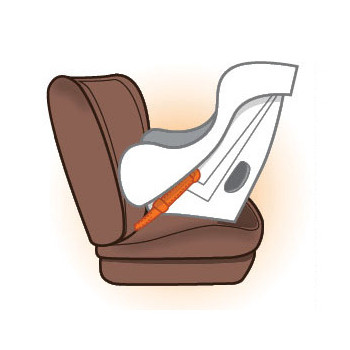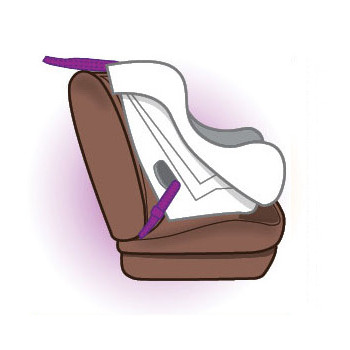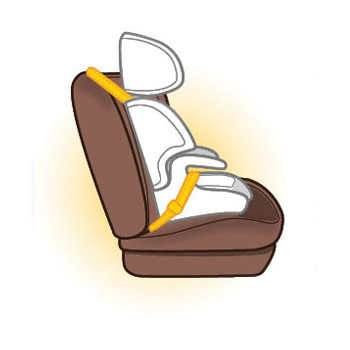
As a parent, you do whatever you can to keep your child safe. Unfortunately, car accidents are the leading cause of injury for young children. Even for parents who do use child seats, small installation mistakes can make the seat less effective, putting the child at increased risk in a crash.
Fortunately, learning how to use a car seat correctly can greatly reduce the likelihood of injury. Here are eight tips for selecting the proper car seat, making sure it is installed correctly and securing your child.
Car Seat Safety: Why Do Young Children Need Car Seats?
For adults, a standard car seat belt greatly reduces the risk and severity of injury. In a crash, wearing a seat belts correctly makes you 47% less likely to die and 52% less likely to be seriously injured according to Transport Canada.
When your car collides with something, it decelerates quickly, but your body keeps moving. By holding you across the pelvis and chest, the seat belt safely stops your movement, preventing you from smashing your head against the steering wheel, being thrown from the car or otherwise applying dangerous forces to your body, making it much more likely you’ll walk away from the accident.
But seat belts are designed for the dimensions of an adult body, and they simply won’t work for young children. That means in an accident, they won’t be properly restrained.
They may slide under the lap belt, jackknife forward injuring their spine, have their neck caught under the shoulder sash or lap belt, or be injured in other ways. Additionally, young children often squirm out of seat belts, preventing the strap from providing any protection whatsoever.
Car seats are designed for children. The seats are the proper size, and the safety restraints are engineered to keep them secure — even when they get squirmy.
In fact, child seats improve child safety more than seat belts do for adults, reducing fatal injuries by 71% and serious injuries by 67%.
Yet, they only work when they’re used correctly. Proper car seat installation, regular safety checks and care strapping in your child are key to keeping your young one safe.
How to Use a Car Seat Correctly
-
Tip 1Choose the Right Car Seat
One of the main challenges of car seat safety is simply choosing the right seat for your child.
There are four basic types of car seats: Rear-facing car seats, front-facing car seats, convertible seats and booster seats. Within those categories, there are many different options, weight and height limits and features, which can make it difficult to make the right choice. Here's what you need to know:
Rear-facing car seats

Rear-facing seats are designed for infants. Rear-facing seats are designed for infants. Most have weight limits of about 16 kg (35 pounds) although specific models may have higher or lower limits.
Rear-facing seats car seats are the safest option for young children and experts typically recommend keeping children in them at least until the age of two — and ideally until they reach the upper weight limit.
Young children have weak spines, which are susceptible to injuries in a crash. By cradling and supporting the head and neck in a crash and distributing crash forces evenly over the child’s body, they make serious injuries much less likely.
Forward-facing car seats

Front or forward-facing car seats are designed for older children. Front or forward-facing car seats are designed for older children. They have a wide range of weight limits, and some go as high as 30 kg (65 lbs).
Like rear-facing models, these car seats have 5-point safety belts or other types of seat belts designed to hold your child securely and distribute force more evenly than a traditional 3-point belt.
Convertible car seats
Convertible seats are just what they sound like; seats that can be mounted either forward or backwards.
That means as your children get older, you can flip the seat instead of buying a new one. There are a wide range of convertible seats with different height and weight limits.
Some go up to 36 kgs (80 lbs) while others have a maximum limit of around half that. There are even 3-in-1 models that can be turned into booster seats when your child is old enough.
Convertible seats can be used for infants in most cases, although very small infants may not meet the lower weight limits of convertible seats.
Rear-facing infant-only car seats have some advantages. Some come as part of a travel system, where the seat can be detached from a base and snapped into a stroller. If your child is asleep, you can remove them from the car without unstrapping them and waking them up, which has obvious benefits for both you and your infant.
Additionally, some parents feel that infants are more comfortable in smaller, infant-only car seats, although that’s anecdotal and likely depends on the model of car seat.
On the other hand, there is some evidence that convertible seats in the rear-facing position may be safer for infants. A recent Consumer Reports study found that infants aged one and older in rear-facing infant seats are more likely to strike and injure their head against the front seat back than they are rear-facing convertible seats.
In crash tests using dummies, “the longer shells and shape of the convertible seats provided additional space between the dummy’s head and the simulated seatback, preventing direct contact of the head.”
Booster seats

Booster seats raise your child higher so that they can sit with the seat belt in the proper position. Booster seats raise your child higher so that they can sit with the seat belt in the proper position. According to Transport Canada you can use booster seats if your child is at least 18 kg (40 lbs) and they are permitted in your province.
As with other seats, graduating prematurely to a booster (or from a booster to just a simple seat belt) increases the risk of injury.
The Canadian Pediatrics Society recommends children remain in boosters at least “until they reach 145 cm in height or 9 years of age and weigh between 18 kg and 36 kg,” although this isn’t legally mandated in all provinces.
A booster seat should allow your child to fit properly in their seat belt. Make sure the lap belt is lying flat across the hips below the abdomen, and the shoulder belt is across the collarbone, not the neck.
-
Tip 2Put the Car Seat in the Back
As a parent, you feel more secure when your child is nearby — where you can watch them. However, from a safety perspective, your child is actually better off in the back.
There are a few reasons for this. First of all, impacts are more likely to occur at the front of the car. Putting your child in the front seat puts them closer to the impact.
That can injure them by exposing their bodies to more force (which can cause internal injuries, even if they’re buckled up correctly). It also potentially places them in the crumple zone, where they could be crushed or cut by the car as it compresses under the force of the crash.
Just as importantly, children in the front seat can be injured by the airbags. Although airbags can provide protection to adolescents and adults, they create a lot of force, which can be dangerous to smaller, more fragile bodies.
Airbags are deployed by explosives, which cause them to expand at 322 km/h (200 mph).
Older children and adults with denser bones can take this impact, but for youngsters it can cause bone fractures and secondary internal injuries, such as hemorrhaging.
And although airbags are designed to deploy in medium to severe crashes, they have been known to inflate at lower speed crashes, where there would normally be little risk of injury (assuming everyone is strapped in).
If practical, install your car seat in the middle of the back seat. This is the safest place in the car for them. However, if you don’t have room (for example, because you have multiple children) installing the child seat in one of the other back seats is fine.
-
Tip 3Use a LATCH Car Seat Whenever Possible
All car seats and vehicles made since 2002 work with the LATCH system (Lower Anchors and Tethers for Children).
Instead of attaching the seat to the seat belt as in older car seats, LATCH seats connect directly to dedicated anchors in the vehicle, for a safer, more secure attachment.
If you own a classic car, consider saving family rides until your kid is older.
-
Tip 4Car Seat Strap Safety—Take Out the Slack
The straps attaching the car seat to the car should be as tight as possible so that the seat doesn’t move around.
When you’re attaching the seat to the LATCH system, press down on the seat and tighten the straps. This will squeeze air out of the vehicle’s seat, allowing you to anchor the car seat more securely.
If you’re using a belt system with a shoulder belt, you’ll need to make sure the belt locks. Once you’ve threaded it through the belt path, pull the shoulder strap all the way out until it locks, then releases it gradually to take up the slack. As with latch systems, you’ll want to press the seat down and tighten the shoulder strap so that the seat doesn’t move.
Rear-facing car seats attack at two points on the bottom. Forward-facing seats have three points, including a strap at the top, which goes over the vehicle’s seat and connects with an anchor behind it.
Once you’re done installing the seat, try to wiggle the seat back and forth. If it moves more than 2.5 centimeters (1 inch) front-to-back or side-to-side, tighten the strap. When in doubt, make it tighter.
As a note, some child seats will have their own system to lock the belt. ALWAYS READ THE MANUAL and follow the manufacturer instructions.
-
Tip 5Adjust the Seat to the Proper Angle
The back of rear facing car seats should angle between 30° and 45°. If it is angled too far back the child will slide towards the front of the car in a crash, putting strain on their neck and shoulders.
Newborns and infants should be reclined at least 35°, since their neck muscles cannot support their heads.
However, older children can be slightly more upright if the position is comfortable for them. Your seat should have an indicator that shows you what angle the seat is inclined at.
Install the seat with your car on level ground to get the proper angle. If the seat isn’t at the proper angle, use a towel or a pool noodle to prop it up.
-
Tip 6Make Sure the Straps are Correctly Positioned on the Child’s Body
The harness should be level with or slightly below the child’s shoulders in the rear-facing position. This will stop the child from sliding towards the front of the car in a crash.
In the front-facing position, however, the harness should be at or above the shoulders. The harness retainer clip (the clip that goes across the chest) should be at the level of the child’s armpits.
The straps should be flat both in back, and in the front where they secure the child. Before installing the seat, check the back where the straps come through the slots, to make sure they’re not twisted anywhere along their path.
When you buckle your child in the straps should be tight enough that you can’t pinch the webbing between your fingers. You should also avoid putting your child in bulky clothes in their car seat, as this extra padding can give them too much movement, making the harness less effective.
-
Tip 7For Convertible Models, Make Sure to Adjust the Car Seat Properly for the Position You’re Using
Your car seat will latch differently in the front and rear position and may have an adjustable bottom piece that sits at different angles in both positions.
Additionally, there is a top strap in convertible seats that is typically not used in the rear-facing position.
-
Tip 8Check your Installation Regularly
Your car seat can become loose over time and your straps can move or twist as you strap and unstrap your kid. Check to make sure your car seat is still secure, and the straps are correctly positioned on your child every time you use it.
